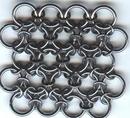"Soft Molecular Crystals" - Hard Matter Physics with Soft Matter Systems
Andreja Sarlah, Thomas Franosch and Erwin Frey
Superimposing optical interference patterns to two-dimensional colloidal systems generates versatile soft matter systems which allow to study the subtle interplay between thermal fluctuations, intermolecular interactions and external potentials on the ordering of the colloidal particles. These systems serve as model systems to study hard matter physics: the interfering laser patterns mimic the substrate potential of a crystalline surface and the assemblies of colloidal particles in the potential minima mimic molecules of various symmetries. Depending on the strength of the fluctuations, the symmetry of the laser patterns and the soft colloidal molecules novel phases emerge.
We have theoretically studied the phase diagram of soft dimer molecules on a triangular substrate potential and found a range of phases, termed "herring bone" phase (resembling the respective tweed fabric) or "Japanese 6/1" phase (named after the weaving pattern in a Japanese chain mail). Whereas the "herring bone" phase has been studied before, the Japanese 6/1 phase is a novel phase of matter with intriguing properties. In this phase order and disorder coexist in immediate vicinity: six perfectly ordered dimer molecules surround a dimer molecule whose orientation is completely random. The same design is found in the weaving pattern of Japanese chain mail, where an inner ring which is free to rotate is linked into 6 rings of fixed orientation. In the future soft molecular crystals will be a source for novel phase behavior with interesting collective properties.


